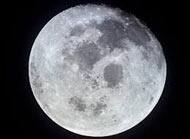Tidal forces gave Moon its shape- 31-Jul-2014
Washington: Tidal forces acting billions of years ago gave Moon the shape it holds now, according to new research.
The shape of the moon deviates from a simple sphere in ways that scientists have struggled to explain.
The study by researchers at University of California Santa Cruz, shows that most of the Moon's overall shape can be explained by taking into account tidal effects acting early in the Moon's history.
The results provide insights into the Moon's early history, its orbital evolution, and its current orientation in the sky, according to lead author Ian Garrick-Bethell, assistant professor of Earth and planetary sciences at UC Santa Cruz.
As the Moon cooled and solidified more than 4 billion years ago, the sculpting effects of tidal and rotational forces became frozen in place.
The idea of a frozen tidal-rotational bulge, known as the "fossil bulge" hypothesis, was first described in 1898.
"If you imagine spinning a water balloon, it will start to flatten at the poles and bulge at the equator," Garrick-Bethell said.
"On top of that you have tides due to the gravitational pull of the Earth, and that creates sort of a lemon shape with the long axis of the lemon pointing at the Earth," said Garrick-Bethell.
But this fossil bulge process cannot fully account for the current shape of the moon. In the new paper, Garrick-Bethell and his coauthors incorporated other tidal effects into their analysis.
They also took into account the large impact basins that have shaped the Moon's topography, and they considered the Moon's gravity field together with its topography.
Efforts to analyse the Moon's overall shape are complicated by the large basins and craters created by powerful impacts that deformed the lunar crust and ejected large amounts of material.
"When we try to analyse the global shape of the Moon using spherical harmonics, the craters are like gaps in the data. We did a lot of work to estimate the uncertainties in the analysis that result from those gaps," Garrick-Bethell said.
Their results indicate that variations in the thickness of the Moon's crust caused by tidal heating during its formation can account for most of the Moon's large-scale topography, while the remainder is consistent with a frozen tidal-rotational bulge that formed later.
Researchers found that the Moon's overall gravity field is no longer aligned with the topography, as it would have been when the tidal bulges were frozen into the Moon's shape.
"The Moon that faced us a long time ago has shifted, so we're no longer looking at the primordial face of the Moon," Garrick-Bethell said.
The study was published in the journal Nature.
No Comments Found!
 Subscription
Subscription 





